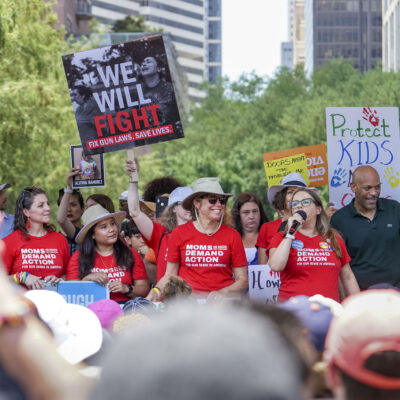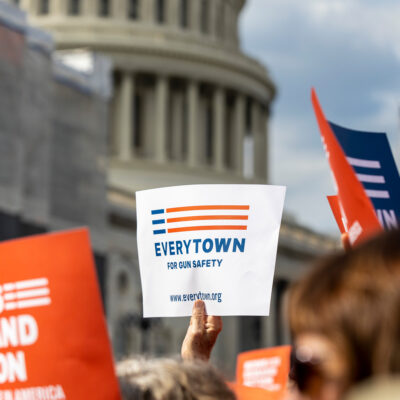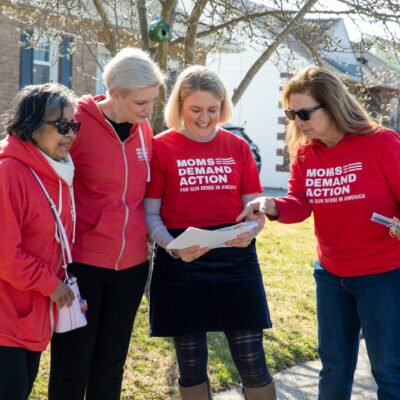Responsible Gun Ownership
What is the problem?
There are an estimated 393 million civilian-owned firearms in the United States.1Aaron Karp, “Estimating Global Civilian-Held Firearms Numbers,” Small Arms Survey, June 2018, https://bit.ly/3snZ9fH. With gun ownership comes responsibility. All gun owners should take certain steps to ensure that their guns are used safely, stored securely, and that they don’t end up in the wrong hands.
All gun owners should be educated on the risks associated with guns and the best practices for storing them securely. Under federal law and the vast majority of state laws, a person is not required to complete firearm safety training before buying a gun. This means a person can purchase a gun without ever having handled one—and in many states, that person would also be allowed to carry it in public without training.
Why is it an issue?
Gun ownership comes with gun responsibility.
An estimated 4.6 million children in the US live in households with at least one unlocked and loaded firearm.1Matthew Miller and Deborah Azrael, “Firearm Storage in US Households with Children: Findings from the 2021 National Firearm Survey,” JAMA Network Open 5, no. 2 (2022): e2148823, https://doi.org/10.1001/jamanetworkopen.2021.48823. It should be no surprise that every year, hundreds of children under the age of 18 unintentionally shoot themselves or someone else in this country. The majority of these incidents take place inside a home. Guns from home or a friend or family member’s home are used in the majority of children firearm suicides2Catherine Barber et al., “Who Owned the Gun in Firearm Suicides of Men, Women, and Youth in Five US States?” Preventive Medicine 164 (2022): 107066, https://doi.org/10.1016/j.ypmed.2022.107066; Namkee G. Choi, Diana M. DiNitto, and C. Nathan Marti, “Youth Firearm Suicide: Precipitating/Risk Factors and Gun Access,” Children and Youth Services Review 83 (December 2017): 9–16, https://doi.org/10.1016/j.childyouth.2017.10.022; Renee M. Johnson et al., “Who Are the Owners of Firearms Used in Adolescent Suicides?,” Suicide & Life-Threatening Behavior 40, no. 6 (2010): 609–11, https://doi.org/10.1521/suli.2010.40.6.609. as well as in incidents of gun violence on school grounds.3National Threat Assessment Center, “Protecting America’s Schools: A US Secret Service Analysis of Targeted School Violence,” US Secret Service, Department of Homeland Security, 2019, https://bit.ly/2U7vnwa. Parents underestimate their children’s curiosity, and the results can be catastrophic. In addition, hundreds of thousands of guns are lost or stolen from private gun owners, gun dealers, or shipping companies every year—over 95 percent of those guns are stolen from private gun owners.4ATF, “National Firearms Commerce and Trafficking Assessment (NFTCA), Volume II: Crime Gun Intelligence and Analysis—Part V: Firearm Thefts,” January 2023, https://www.atf.gov/firearms/docs/report/nfcta-volume-ii-part-v-firearm-thefts/download. And gun thefts from cars are on the rise. We are all safer when gun owners are responsible and store their firearms securely.
By the numbers
393M
There are an estimated 393 million civilian-owned firearms in the United States, and more than one-third of homes contain at least one gun.
3x
Access to a gun triples the risk of death by suicide.
2x
Access to a gun doubles the risk of death by homicide.
>200,000
On average, more than 200,000 guns are stolen from private gun owners each year.
What are the solutions?
-
Secure Gun Storage
Gun owners can make their homes and communities safer by storing their guns securely. This means storing them unloaded, locked, and separate from ammunition.
-
Gun Owner Safety Training
States should require a person to complete safety training prior to purchasing a gun or carrying a gun in public. Training ensures that gun owners are educated on the responsible practices for handling and using firearms, storing them securely at home and in vehicles, as well as carrying guns in public.
-
Report Lost and Stolen Guns
Hundreds of thousands of guns are lost or stolen from private gun owners, gun dealers, or shipping companies every year.1ATF, “National Firearms Commerce and Trafficking Assessment (NFTCA), Volume II: Crime Gun Intelligence and Analysis—Part V: Firearm Thefts,” January 2023, https://www.atf.gov/firearms/docs/report/nfcta-volume-ii-part-v-firearm-thefts/download. Requiring that lost and stolen guns be reported to law enforcement deters illegal gun trafficking. The reporting of these guns allows the police to respond more quickly to gun thefts and helps them identify tracking patterns.
-
Smart Guns and Gun Safety Features
A personalized—or “smart”—gun is a firearm that employs authorized-use technology, like the thumb scan or passcode available on many smartphones, to turn stolen guns and guns accessed by children into harmless pieces of steel. If widely implemented, it would be a game-changer for keeping guns out of the hands of children and criminals.
-
Educate Gun Owners of Risks
It is critical that gun buyers and permit applicants are given safety information. Requiring gun dealers to inform purchasers of the risks associated with firearms allows buyers to make educated decisions about owning and storing guns and is a meaningful step towards preventing gun violence.





